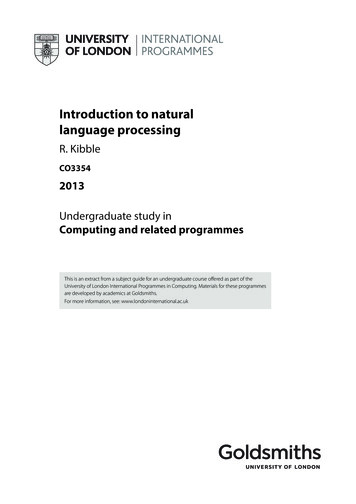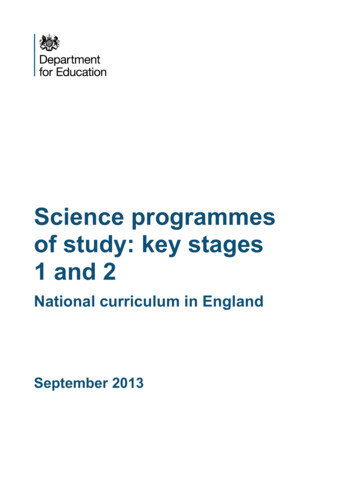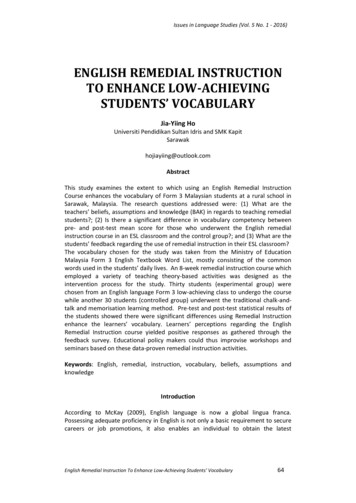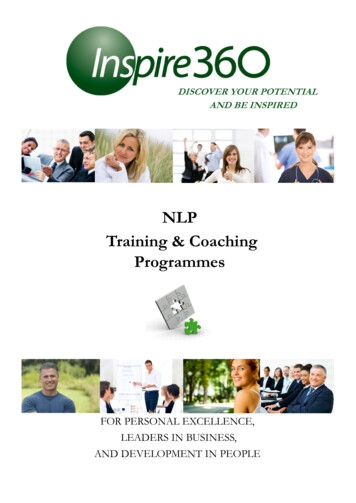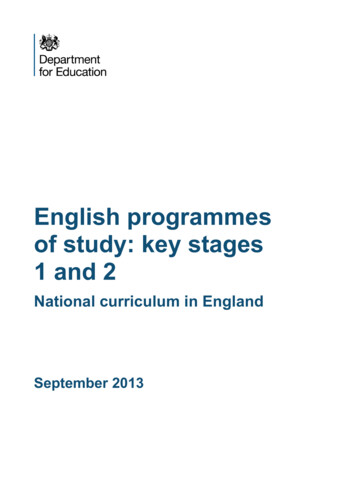
Transcription
English programmesof study: key stages1 and 2National curriculum in EnglandSeptember 2013
ContentsSpoken language – years 1 to 67Key stage 1 – year 19Key stage 1 – year 216Lower key stage 2 – years 3 and 423Upper key stage 2 – years 5 and 631English Appendix 1: Spelling39Spelling – work for year 140Spelling – work for year 245Spelling – work for years 3 and 449Word list – years 3 and 454Spelling – years 5 and 656Word list – years 5 and 661International Phonetic Alphabet (non-statutory)63English Appendix 2: Vocabulary, grammar and punctuation64Glossary for the programmes of study for English (non-statutory)70
English – key stages 1 and 2Purpose of studyEnglish has a pre-eminent place in education and in society. A high-quality education inEnglish will teach pupils to speak and write fluently so that they can communicate theirideas and emotions to others and through their reading and listening, others cancommunicate with them. Through reading in particular, pupils have a chance to developculturally, emotionally, intellectually, socially and spiritually. Literature, especially, plays akey role in such development. Reading also enables pupils both to acquire knowledge andto build on what they already know. All the skills of language are essential to participatingfully as a member of society; pupils, therefore, who do not learn to speak, read and writefluently and confidently are effectively disenfranchised.AimsThe overarching aim for English in the national curriculum is to promote high standards oflanguage and literacy by equipping pupils with a strong command of the spoken andwritten word, and to develop their love of literature through widespread reading forenjoyment. The national curriculum for English aims to ensure that all pupils: read easily, fluently and with good understanding develop the habit of reading widely and often, for both pleasure and information acquire a wide vocabulary, an understanding of grammar and knowledge of linguisticconventions for reading, writing and spoken language appreciate our rich and varied literary heritage write clearly, accurately and coherently, adapting their language and style in and for arange of contexts, purposes and audiences use discussion in order to learn; they should be able to elaborate and explain clearlytheir understanding and ideas are competent in the arts of speaking and listening, making formal presentations,demonstrating to others and participating in debate.Spoken languageThe national curriculum for English reflects the importance of spoken language in pupils’development across the whole curriculum – cognitively, socially and linguistically. Spokenlanguage underpins the development of reading and writing. The quality and variety oflanguage that pupils hear and speak are vital for developing their vocabulary and grammarand their understanding for reading and writing. Teachers should therefore ensure thecontinual development of pupils’ confidence and competence in spoken language andlistening skills. Pupils should develop a capacity to explain their understanding of booksand other reading, and to prepare their ideas before they write. They must be assisted inmaking their thinking clear to themselves as well as to others and teachers should ensurethat pupils build secure foundations by using discussion to probe and remedy their3
English – key stages 1 and 2misconceptions. Pupils should also be taught to understand and use the conventions fordiscussion and debate.All pupils should be enabled to participate in and gain knowledge, skills and understandingassociated with the artistic practice of drama. Pupils should be able to adopt, create andsustain a range of roles, responding appropriately to others in role. They should haveopportunities to improvise, devise and script drama for one another and a range ofaudiences, as well as to rehearse, refine, share and respond thoughtfully to drama andtheatre performances.Statutory requirements which underpin all aspects of spoken language across the sixyears of primary education form part of the national curriculum. These are reflected andcontextualised within the reading and writing domains which follow.ReadingThe programmes of study for reading at key stages 1 and 2 consist of two dimensions: word reading comprehension (both listening and reading).It is essential that teaching focuses on developing pupils’ competence in both dimensions;different kinds of teaching are needed for each.Skilled word reading involves both the speedy working out of the pronunciation ofunfamiliar printed words (decoding) and the speedy recognition of familiar printed words.Underpinning both is the understanding that the letters on the page represent the soundsin spoken words. This is why phonics should be emphasised in the early teaching ofreading to beginners (i.e. unskilled readers) when they start school.Good comprehension draws from linguistic knowledge (in particular of vocabulary andgrammar) and on knowledge of the world. Comprehension skills develop through pupils’experience of high-quality discussion with the teacher, as well as from reading anddiscussing a range of stories, poems and non-fiction. All pupils must be encouraged toread widely across both fiction and non-fiction to develop their knowledge of themselvesand the world in which they live, to establish an appreciation and love of reading, and togain knowledge across the curriculum. Reading widely and often increases pupils’vocabulary because they encounter words they would rarely hear or use in everydayspeech. Reading also feeds pupils’ imagination and opens up a treasure-house of wonderand joy for curious young minds.It is essential that, by the end of their primary education, all pupils are able to read fluently,and with confidence, in any subject in their forthcoming secondary education.4
English – key stages 1 and 2WritingThe programmes of study for writing at key stages 1 and 2 are constructed similarly tothose for reading: transcription (spelling and handwriting) composition (articulating ideas and structuring them in speech and writing).It is essential that teaching develops pupils’ competence in these two dimensions. Inaddition, pupils should be taught how to plan, revise and evaluate their writing. Theseaspects of writing have been incorporated into the programmes of study for composition.Writing down ideas fluently depends on effective transcription: that is, on spelling quicklyand accurately through knowing the relationship between sounds and letters (phonics) andunderstanding the morphology (word structure) and orthography (spelling structure) ofwords. Effective composition involves forming, articulating and communicating ideas, andthen organising them coherently for a reader. This requires clarity, awareness of theaudience, purpose and context, and an increasingly wide knowledge of vocabulary andgrammar. Writing also depends on fluent, legible and, eventually, speedy handwriting.Spelling, vocabulary, grammar, punctuation and glossaryThe two statutory appendices – on spelling and on vocabulary, grammar and punctuation– give an overview of the specific features that should be included in teaching theprogrammes of study.Opportunities for teachers to enhance pupils’ vocabulary arise naturally from their readingand writing. As vocabulary increases, teachers should show pupils how to understand therelationships between words, how to understand nuances in meaning, and how to developtheir understanding of, and ability to use, figurative language. They should also teachpupils how to work out and clarify the meanings of unknown words and words with morethan one meaning. References to developing pupils’ vocabulary are also included withinthe appendices.Pupils should be taught to control their speaking and writing consciously and to useStandard English. They should be taught to use the elements of spelling, grammar,punctuation and ‘language about language’ listed. This is not intended to constrain orrestrict teachers’ creativity, but simply to provide the structure on which they can constructexciting lessons. A non-statutory Glossary is provided for teachers.Throughout the programmes of study, teachers should teach pupils the vocabulary theyneed to discuss their reading, writing and spoken language. It is important that pupils learnthe correct grammatical terms in English and that these terms are integrated withinteaching.5
English – key stages 1 and 2School curriculumThe programmes of study for English are set out year-by-year for key stage 1 and twoyearly for key stage 2. The single year blocks at key stage 1 reflect the rapid pace ofdevelopment in word reading during these two years. Schools are, however, only requiredto teach the relevant programme of study by the end of the key stage. Within each keystage, schools therefore have the flexibility to introduce content earlier or later than set outin the programme of study. In addition, schools can introduce key stage content during anearlier key stage if appropriate. All schools are also required to set out their schoolcurriculum for English on a year-by-year basis and make this information available online.Attainment targetsBy the end of each key stage, pupils are expected to know, apply and understand thematters, skills and processes specified in the relevant programme of study.Schools are not required by law to teach the example content in [square brackets]or the content indicated as being ‘non-statutory’.6
English – key stages 1 and 2Spoken language – years 1 to 6Spoken languageStatutory requirementsPupils should be taught to: listen and respond appropriately to adults and their peers ask relevant questions to extend their understanding and knowledge use relevant strategies to build their vocabulary articulate and justify answers, arguments and opinions give well-structured descriptions, explanations and narratives for different purposes,including for expressing feelings maintain attention and participate actively in collaborative conversations, staying ontopic and initiating and responding to comments use spoken language to develop understanding through speculating, hypothesising,imagining and exploring ideas speak audibly and fluently with an increasing command of Standard English participate in discussions, presentations, performances, role play, improvisations anddebates gain, maintain and monitor the interest of the listener(s) consider and evaluate different viewpoints, attending to and building on thecontributions of others select and use appropriate registers for effective communication.Notes and guidance (non-statutory)These statements apply to all years. The content should be taught at a level appropriateto the age of the pupils. Pupils should build on the oral language skills that have beentaught in preceding years.Pupils should be taught to develop their competence in spoken language and listening toenhance the effectiveness with which they are able to communicate across a range ofcontexts and to a range of audiences. They should therefore have opportunities to workin groups of different sizes – in pairs, small groups, large groups and as a whole class.Pupils should understand how to take turns and when and how to participateconstructively in conversations and debates.Attention should also be paid to increasing pupils’ vocabulary, ranging from describing7
English – key stages 1 and 2Notes and guidance (non-statutory)their immediate world and feelings to developing a broader, deeper and richervocabulary to discuss abstract concepts and a wider range of topics, and to enhancingtheir knowledge about language as a whole.Pupils should receive constructive feedback on their spoken language and listening, notonly to improve their knowledge and skills but also to establish secure foundations foreffective spoken language in their studies at primary school, helping them to achieve insecondary education and beyond.8
English – key stages 1 and 2Key stage 1 – year 1During year 1, teachers should build on work from the Early Years Foundation Stage,making sure that pupils can sound and blend unfamiliar printed words quickly andaccurately using the phonic knowledge and skills that they have already learnt. Teachersshould also ensure that pupils continue to learn new grapheme-phonemecorrespondences (GPCs) and revise and consolidate those learnt earlier. Theunderstanding that the letter(s) on the page represent the sounds in spoken words shouldunderpin pupils’ reading and spelling of all words. This includes common words containingunusual GPCs. The term ‘common exception words’ is used throughout the programmesof study for such words.Alongside this knowledge of GPCs, pupils need to develop the skill of blending the soundsinto words for reading and establish the habit of applying this skill whenever theyencounter new words. This will be supported by practice in reading books consistent withtheir developing phonic knowledge and skill and their knowledge of common exceptionwords. At the same time they will need to hear, share and discuss a wide range of highquality books to develop a love of reading and broaden their vocabulary.Pupils should be helped to read words without overt sounding and blending after a fewencounters. Those who are slow to develop this skill should have extra practice.Pupils’ writing during year 1 will generally develop at a slower pace than their reading. Thisis because they need to encode the sounds they hear in words (spelling skills), developthe physical skill needed for handwriting, and learn how to organise their ideas in writing.Pupils entering year 1 who have not yet met the early learning goals for literacy shouldcontinue to follow their school’s curriculum for the Early Years Foundation Stage to developtheir word reading, spelling and language skills. However, these pupils should follow theyear 1 programme of study in terms of the books they listen to and discuss, so that theydevelop their vocabulary and understanding of grammar, as well as their knowledge moregenerally across the curriculum. If they are still struggling to decode and spell, they needto be taught to do this urgently through a rigorous and systematic phonics programme sothat they catch up rapidly.Teachers should ensure that their teaching develops pupils’ oral vocabulary as well astheir ability to understand and use a variety of grammatical structures, giving particularsupport to pupils whose oral language skills are insufficiently developed.9
English – key stages 1 and 2Year 1 programme of studyReading – word readingStatutory requirementsPupils should be taught to: apply phonic knowledge and skills as the route to decode words respond speedily with the correct sound to graphemes (letters or groups of letters)for all 40 phonemes, including, where applicable, alternative sounds for graphemes read accurately by blending sounds in unfamiliar words containing GPCs that havebeen taught read common exception words, noting unusual correspondences between spellingand sound and where these occur in the word read words containing taught GPCs and –s, –es, –ing, –ed, –er and –est endings read other words of more than one syllable that contain taught GPCs read words with contractions [for example, I’m, I’ll, we’ll], and understand that theapostrophe represents the omitted letter(s) read aloud accurately books that are consistent with their developing phonicknowledge and that do not require them to use other strategies to work out words re-read these books to build up their fluency and confidence in word reading.Notes and guidance (non-statutory)Pupils should revise and consolidate the GPCs and the common exception words taughtin Reception. As soon as they can read words comprising the year 1 GPCs accuratelyand speedily, they should move on to the year 2 programme of study for word reading.The number, order and choice of exception words taught will vary according to thephonics programme being used. Ensuring that pupils are aware of the GPCs theycontain, however unusual these are, supports spelling later.Young readers encounter words that they have not seen before much more frequentlythan experienced readers do, and they may not know the meaning of some of these.Practice at reading such words by sounding and blending can provide opportunities notonly for pupils to develop confidence in their decoding skills, but also for teachers toexplain the meaning and thus develop pupils’ vocabulary.10
English – key stages 1 and 2Notes and guidance (non-statutory)Pupils should be taught how to read words with suffixes by being helped to build on theroot words that they can read already. Pupils’ reading and re-reading of books that areclosely matched to their developing phonic knowledge and knowledge of commonexception words supports their fluency, as well as increasing their confidence in theirreading skills. Fluent word reading greatly assists comprehension, especially whenpupils come to read longer books.Reading – comprehensionStatutory requirementsPupils should be taught to: develop pleasure in reading, motivation to read, vocabulary and understanding by: listening to and discussing a wide range of poems, stories and non-fiction at alevel beyond that at which they can read independently being encouraged to link what they read or hear read to their own experiences becoming very familiar with key stories, fairy stories and traditional tales,retelling them and considering their particular characteristics recognising and joining in with predictable phrases learning to appreciate rhymes and poems, and to recite some by heart discussing word meanings, linking new meanings to those already knownunderstand both the books they can already read accurately and fluently and thosethey listen to by: drawing on what they already know or on background information andvocabulary provided by the teacher checking that the text makes sense to them as they read and correctinginaccurate reading discussing the significance of the title and events making inferences on the basis of what is being said and done predicting what might happen on the basis of what has been read so far participate in discussion about what is read to them, taking turns and listening towhat others say explain clearly their understanding of what is read to them.11
English – key stages 1 and 2Notes and guidance (non-statutory)Pupils should have extensive experience of listening to, sharing and discussing a widerange of high-quality books with the teacher, other adults and each other to engender alove of reading at the same time as they are reading independently.Pupils’ vocabulary should be developed when they listen to books read aloud and whenthey discuss what they have heard. Such vocabulary can also feed into their writing.Knowing the meaning of more words increases pupils’ chances of understanding whenthey read by themselves. The meaning of some new words should be introduced topupils before they start to read on their own, so that these unknown words do not holdup their comprehension.However, once pupils have already decoded words successfully, the meaning of thosethat are new to them can be discussed with them, so contributing to developing theirearly skills of inference. By listening frequently to stories, poems and non-fiction thatthey cannot yet read for themselves, pupils begin to understand how written languagecan be structured in order, for example, to build surprise in narratives or to present factsin non-fiction. Listening to and discussing information books and other non-fictionestablishes the foundations for their learning in other subjects. Pupils should be shownsome of the processes for finding out information.Through listening, pupils also start to learn how language sounds and increase theirvocabulary and awareness of grammatical structures. In due course, they will be able todraw on such grammar in their own writing.Rules for effective discussions should be agreed with and demonstrated for pupils. Theyshould help to develop and evaluate them, with the expectation that everyone takes part.Pupils should be helped to consider the opinions of others.Role-play can help pupils to identify with and explore characters and to try out thelanguage they have listened to.Writing – transcriptionStatutory requirementsSpelling (see English Appendix 1)Pupils should be taught to: 12spell: words containing each of the 40 phonemes already taught common exception words the days of the week
English – key stages 1 and 2Statutory requirements name the letters of the alphabet: naming the letters of the alphabet in order using letter names to distinguish between alternative spellings of the samesoundadd prefixes and suffixes: using the spelling rule for adding –s or –es as the plural marker for nouns andthe third person singular marker for verbs using the prefix un– using –ing, –ed, –er and –est where no change is needed in the spelling of rootwords [for example, helping, helped, helper, eating, quicker, quickest] apply simple spelling rules and guidance, as listed in English Appendix 1 write from memory simple sentences dictated by the teacher that include words usingthe GPCs and common exception words taught so far.Notes and guidance (non-statutory)Reading should be taught alongside spelling, so that pupils understand that they canread back words they have spelt.Pupils should be shown how to segment spoken words into individual phonemes andthen how to represent the phonemes by the appropriate grapheme(s). It is important torecognise that phoneme-grapheme correspondences (which underpin spelling) are morevariable than grapheme-phoneme correspondences (which underpin reading). For thisreason, pupils need to do much more word-specific rehearsal for spelling than forreading.At this stage pupils will be spelling some words in a phonically plausible way, even ifsometimes incorrectly. Misspellings of words that pupils have been taught to spellshould be corrected; other misspelt words should be used to teach pupils aboutalternative ways of representing those sounds.Writing simple dictated sentences that include words taught so far gives pupilsopportunities to apply and practise their spelling.13
English – key stages 1 and 2Statutory requirementsHandwritingPupils should be taught to: sit correctly at a table, holding a pencil comfortably and correctly begin to form lower-case letters in the correct direction, starting and finishing in theright place form capital letters form digits 0-9 understand which letters belong to which handwriting ‘families’ (i.e. letters that areformed in similar ways) and to practise these.Notes and guidance (non-statutory)Handwriting requires frequent and discrete, direct teaching. Pupils should be able toform letters correctly and confidently. The size of the writing implement (pencil, pen)should not be too large for a young pupil’s hand. Whatever is being used should allowthe pupil to hold it easily and correctly so that bad habits are avoided.Left-handed pupils should receive specific teaching to meet their needs.Writing – compositionStatutory requirementsPupils should be taught to: write sentences by: saying out loud what they are going to write about composing a sentence orally before writing it sequencing sentences to form short narratives re-reading what they have written to check that it makes sense discuss what they have written with the teacher or other pupils read aloud their writing clearly enough to be heard by their peers and the teacher.14
English – key stages 1 and 2Notes and guidance (non-statutory)At the beginning of year 1, not all pupils will have the spelling and handwriting skills theyneed to write down everything that they can compose out loud.Pupils should understand, through demonstration, the skills and processes essential towriting: that is, thinking aloud as they collect ideas, drafting, and re-reading to checktheir meaning is clear.Writing – vocabulary, grammar and punctuationStatutory requirementsPupils should be taught to: develop their understanding of the concepts set out in English Appendix 2 by: leaving spaces between words joining words and joining clauses using and beginning to punctuate sentences using a capital letter and a full stop, questionmark or exclamation mark using a capital letter for names of people, places, the days of the week, and thepersonal pronoun ‘I’ learning the grammar for year 1 in English Appendix 2use the grammatical terminology in English Appendix 2 in discussing their writing.Notes and guidance (non-statutory)Pupils should be taught to recognise sentence boundaries in spoken sentences and touse the vocabulary listed in English Appendix 2 (‘Terminology for pupils’) when theirwriting is discussed.Pupils should begin to use some of the distinctive features of Standard English in theirwriting. ‘Standard English’ is defined in the Glossary.15
English – key stages 1 and 2Key stage 1 – year 2By the beginning of year 2, pupils should be able to read all common graphemes. Theyshould be able to read unfamiliar words containing these graphemes, accurately andwithout undue hesitation, by sounding them out in books that are matched closely to eachpupil’s level of word reading knowledge. They should also be able to read many commonwords containing GPCs taught so far [for example, shout, hand, stop, or dream], withoutneeding to blend the sounds out loud first. Pupils’ reading of common exception words [forexample, you, could, many, or people], should be secure. Pupils will increase their fluencyby being able to read these words easily and automatically. Finally, pupils should be ableto retell some familiar stories that have been read to and discussed with them or that theyhave acted out during year 1.During year 2, teachers should continue to focus on establishing pupils’ accurate andspeedy word reading skills. They should also make sure that pupils listen to and discuss awide range of stories, poems, plays and information books; this should include wholebooks. The sooner that pupils can read well and do so frequently, the sooner they will beable to increase their vocabulary, comprehension and their knowledge across the widercurriculum.In writing, pupils at the beginning of year 2 should be able to compose individualsentences orally and then write them down. They should be able to spell correctly many ofthe words covered in year 1 (see English Appendix 1). They should also be able to makephonically plausible attempts to spell words they have not yet learnt. Finally, they shouldbe able to form individual letters correctly, so establishing good handwriting habits from thebeginning.It is important to recognise that pupils begin to meet extra challenges in terms of spellingduring year 2. Increasingly, they should learn that there is not always an obviousconnection between the way a word is said and the way it is spelt. Variations includedifferent ways of spelling the same sound, the use of so-called silent letters and groups ofletters in some words and, sometimes, spelling that has become separated from the waythat words are now pronounced, such as the ‘le’ ending in table. Pupils’ motor skills alsoneed to be sufficiently advanced for them to write down ideas that they may be able tocompose orally. In addition, writing is intrinsically harder than reading: pupils are likely tobe able to read and understand more complex writing (in terms of its vocabulary andstructure) than they are capable of producing themselves.For pupils who do not have the phonic knowledge and skills they need for year 2, teachersshould use the year 1 programmes of study for word reading and spelling so that pupils’word reading skills catch up. However, teachers should use the year 2 programme ofstudy for comprehension so that these pupils hear and talk about new books, poems, otherwriting, and vocabulary with the rest of the class.16
English – key stages 1 and 2Year 2 programme of studyReading – word readingStatutory requirementsPupils should be taught to: continue to apply phonic knowledge and skills as the route to decode words untilautomatic decoding has become embedded and reading is fluent read accurately by blending the sounds in words that contain the graphemes taughtso far, especially recognising alternative sounds for graphemes read accurately words of two or more syllables that contain the same graphemes asabove read words containing common suffixes read further common exception words, noting unusual correspondences betweenspelling and sound and where these occur in the word read most words quickly and accurately, without overt sounding and blending, whenthey have been frequently encountered read aloud books closely matched to their improving phonic knowledge, sounding outunfamiliar words accurately, automatically and without undue hesitation re-read these books to build up their fluency and confidence in word reading.Notes and guidance (non-statutory)Pupils should revise and consolidate the GPCs and the common exception words taughtin year 1. The exception words taught will vary slightly, depending on the phonicsprogramme being used. As soon as pupils can read words comprising the year 2 GPCsaccurately and speedily, they should move on to the years 3 and 4 programme of studyfor word reading.When pupils are taught how to read longer words, they should be shown syllable boundariesand how to read each syllable separately before they combine them to read the word.Pupils should be taught how to read suffixes by building on the root words that they havealready learnt. The whole suffix should be taught as well as the letters that make it up.Pupils who are still at the early stages of learning to read should have ample practice inreading books that are closely matched to their developing phonic knowledge andknowledge of common exception words. As soon as the decoding of most regular wordsand comm
Spoken language – years 1 to 6 7 Key stage 1 – year 1 9 Key stage 1 – year 2 16 Lower key stage 2 – years 3 and 4 23 Upper key stage 2 – years 5 and 6 31 English Appendix 1: Spelling 39 Spelling – work for year 1 40 Spelling – work for year 2 45 Spelling – work for years 3 and 4 49
